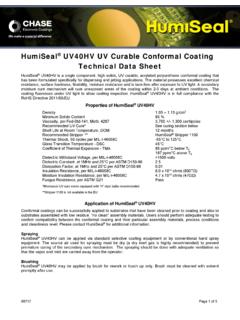Transcription of P7 - Printing with UV-curable inks and coatings
1 Health and Safety Executive P7 7 Printing with UV-curable inks and coatingsCOSHH essentials for printers Lithographic Printing This information is intended to help employers in the Printing industry comply with the requirements of Hazardous to Health Regulations 2002 (COSHH), as amended, to control exposure to chemicals and protect workers' health. the Control of Substances It is also useful for trade union safety representatives. This sheet describes good practice for Printing with UV-curable inks where the ink-curing lamps generate ozone. Use extraction for any ozone produced.
2 Main points Avoid skin contact with UV curable inks - these can cause dermatitis. Carry out health surveillance for dermatitis. Check the supplier's safety data sheet - the ink should conform to the 'Acrylate Preference Criteria'. If not, seek advice from your supplier. Protect eyes and skin from UV light. Access and premises Only allow authorised staff access to the press room. Provide good facilities for washing, skin care, and for taking refreshments. Equipment Provide a good standard of general ventilation. Use powered wall- or window-mounted fans to supply fresh air - five to ten air changes per hour, with a through draught.
3 Extraction and general ventilation for Printing with UV-curable inks where the lamps generate ozone Provide splash-resistant gloves. Screen UV curing units with fixed or interlocked covers. Avoid leaks of UV light. Set up the machine to avoid ink misting. Use mist extraction or shroud the rollers to trap the mist. Can you use water-cooling on cylinders? Consider using water-cooled UV lamps. These generate less ozone. Wire in ozone extraction to the UV lamp power supply. For air-cooled lamps, you need an inward airflow between and 1 metre per second at openings. To reduce ink mist, you need an airflow between 1 and metres per second into openings.
4 Fit a manometer, pressure gauge or tell-tale to show that extraction is working. Lithographic Printing P7 Maintenance, examination and testing Follow the instructions in the maintenance manual - keep equipment in effective and efficient working order. If the machine extraction stops, or is faulty, get it repaired straight away. Don't alter, add or remove extraction without specialist advice. Ensure that screens on the UV units are secure and any interlocks are in working order. Daily, look for signs of damage. Repair damage immediately. Noisy or vibrating fans indicate a problem.
5 Do repairs as necessary. At least once a week, check that the extraction system and gauges work properly. You need to know the manufacturer's performance specifications to know if extraction is working properly. If this information isn't available, hire a competent ventilation engineer to determine the performance needed for effective control. The engineer's report must show the target extraction rates. Keep this information in your testing logbook. Get a competent ventilation engineer to examine the extraction thoroughly and test its performance at least once every 14 months see HSE publication HSG54.
6 Keep records of all examinations and tests for at least five years. Personal protective equipment (PPE) Provide storage for PPE to prevent damage or contamination when not in use. Respiratory protective equipment (RPE) Respiratory protective equipment should not be needed for routine use. Gloves Use splash-resistant gloves where there is a risk of skin contact -single-use nitrile gloves mm thick are acceptable. Tell workers to dispose of single-use gloves every time they take them off. Other protective equipment Cotton overalls to minimise clothing contamination.
7 Change contaminated overalls immediately and ensure they are laundered before re-use. Skin management Skin contact with UV-curable inks and coatings may cause dermatitis. Skin care Keep hands clean and in good condition. Using pre-work creams helps make removing chemicals easier. However, pre-work creams should not be seen as a substitute for gloves. If you need to use hand cleansers to remove ink, ensure that the cleanser is rinsed off afterwards. Lithographic Printing P7 Provide after-work creams (moisturisers) to replace skin oils. Never allow solvents to be used for cleaning skin.
8 Skin surveillance/checks Health surveillance for dermatitis is required. See sheet P45. Seek advice from an occupational health professional in setting up a surveillance programme. Start surveillance for new workers within six weeks of their starting work. Then check at monthly intervals or as advised by your health professional. Cleaning and housekeeping Keep the work area tidy, clean and free of ink contamination. Clean the workroom at least once a week. Store contaminated cloths, wipes and gloves in fire-resisting, closed, metal containers. Dispose of them as hazardous waste.
9 Handle containers with care and replace caps. Wipe off any liquid on the outside of the container. Clean up spills immediately. Use an impervious apron and new nitrile gloves mm thick. Throw away gloves once used. Store containers in a safe place, securely closed. Dispose of waste solvent, ink and empty containers as hazardous waste. Use a contract laundry or a suitable equivalent to wash work clothing. Don't do this at home. Training and supervision Working in the right way is important for exposure control. Train and supervise workers - see details in sheet P0.
10 Warn about the dermatitis risk from UV-curable inks. Environmental guidelines Releases into the air may be regulated within the Pollution Prevention and Control (PPC) framework. Your local authority or the Environment Agency will tell you if PPC applies to your company, and give advice on air cleaning and discharging emissions. In Scotland, consult the Scottish Environment Protection Agency (SEPA). For more information, see Further information The printer's guide to health and safety (Second edition) HSE Books 2002 ISBN 0 7176 2267 3 Skin problems in the Printing industry Leaflet IACL101(rev1) HSE Books 2002 (single copy free or priced packs of 15 ISBN 0 7176 2322 X) General ventilation in the workplace.

















